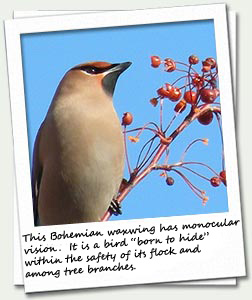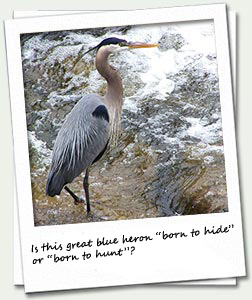 |
 |
||||||
|
|
Food, Water and Shelter
|
Science: Bird Life - Camouflage and Vision Have you ever seen a broad-winged hawk near the Concord River?
Chances are you would miss this particular raptor because of the
color and pattern of its feathers blend in so well with the trees.
This is called camouflage. For birds, especially
small hawks, camouflage is very important because it protects them
from predators and helps them to capture prey.
Bird Vision 
Can you think of a mammal with monocular vision? (Think of another animal that often prey and “born to hide”). Birds such as raptors have binocular vision. Raptors are bird of prey known for hunting by capturing prey with their sharp and powerful talons. Because their eyes are in the front of their head, they can identify prey at great distance and strike with precision. We say of such birds, “Eyes on the front, born to hunt." Song birds and birds of prey are well matched, as song birds are masters of hiding from predators while birds of prey are masters of hunting. Who will come out on top is a matter of skill, experience, and chance. Can you think of a mammal with binocular vision? (Think of an animal that is “born to hunt”; predator.)
Great blue herons are known for their slow-moving, patient hunting tactics, which allow them to ambush and capture prey in shallow water. They are also known for their large size. Their size, as well as monocular vision helps herons to protect themselves from the pursuit of predators and detect subtle movement of prey. While monocular vision may imply that the heron is prey, its spear-like beak shape implies that it is also a predator. The great blue heron is born to hide and hunt. Many other animals also exhibit features of both predator and prey. |


